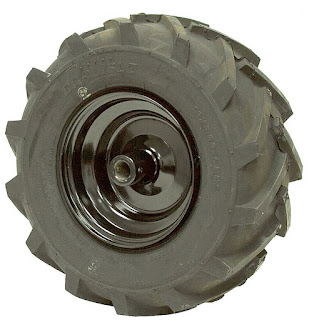Drive Basics
Actually, I have been thinking about this for over a year, but only recently started to put a serious effort towards it. I had originally wanted a tracked version, but exhausted finding a cost effective source for tracks. Some folks have made their own by machining thick rubber strips and gluing them together. I really didn't think this would stand the abuse of rough terrain. Someone suggested using V Belts with cleats, but that might be too aggressive. I'm still looking.
So, back to the 6x6 idea. What really triggered the whole project is the availability of certain key parts, namely wheels and motors. Tires are expensive, times 6 and you get the idea. Wheelchair motors are also expensive, but EBay is the solution there.
Tires - I came across some nice Carlise Super Lug 13x5.00-6 tires at Surplus Center for $32.95 a pair. They have a 3/4 bore hub. There are also individual ones for slightly less with a 1 inch hub, but I didn't want axles that big, nor do I want to sleeve/adapt them.
Motors - Searching EBay and reading a lot about wheelchair motors yielded a pair of Sunrise Medical S525 motors:
They aren't "perfect" but the price was right. Finding specs for these things is nearly impossible as they are typically customized for each manufacturer. These are ElectroCraft 24V DC brush motors into a roughly 18:1 right angle gear box. The shafts (after removing the hubs) are tapered, but I can deal with that. Ideally a straight shaft is easier to deal with, but again - price. These things are heavy.
Many different chair manufacturers use different diameter wheels, spec different speeds and weight capacity. I chose a taller gear ratio 18:1 for a faster shaft speed so I could then gear it down myself. This minimizes the torque load on the motor itself, and thus the current. If I had a slower motor, the final drive could be closer to 1:1, but the gearbox torque specs are relatively constant no matter what the ratio, so to avoid running into that it seemed best to go this way.
A quick set of Excel calculations of total weight, desired speed, angle of climb, etc. yielded a set of guidelines for maximum torque required as well as the tractive torque that can be delivered to the ground at each wheel. It doesn't do any good if you need a ton of torque, can supply it, but the wheels spin and just dig in.
From this evolved a design. The goals are:
- 6 wheel drive
- Tank type steering
- 24 VDC drive system
- Gas powered 22 inch mower, adjustable height up to 6 inches
- Radio Control ( with throttle cut safeties )
- optional additional channels for additional functions and maybe telemetry
- optional alternator to charge drive batteries
Below is a snapshot of the CAD design ( I use AutoCAD ).
This helped to guide drive design and bearing selection.
Roller chain is straighforward. 17 tooth drive sprocket, 60 tooth driven sprocket, 20 tooth wheel to wheel connecting sprockets. I sometimes call them gears, but I mean sprockets.
Bearings are 3/4 inch bore pillow blocks. They are relatively mounting insensitive and are greasable/sealed units. I toyed with the idea of discrete bearings, but the mounting is important and the ability to grease them is too.
Again, a great source for all of this is Surplus Center. I ordered all the bearings, sprockets, chain and master links from them. They are the cheapest I could find, and the quality is decent. The bearing blocks were about $5.60 or so, compare to $30 to $75 elsewhere.
The frame is 1x1 inch steel tubing, and the axles are 3/4 inch cold rolled steel. I purchase my steel from Klein Steel Direct in Rochester, NY. Typical prices are about 70 cents per pound. 24 feet of tube and 6 foot of shaft cost about $28.
I'm cutting the steel roughly to length with a recip saw, then cleaning up the ends separately.
TTFN














